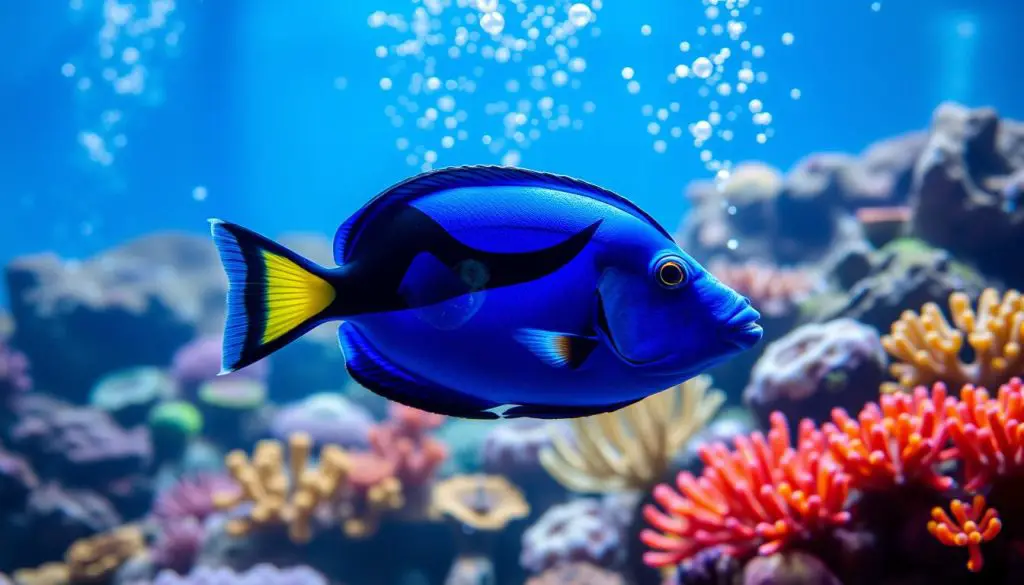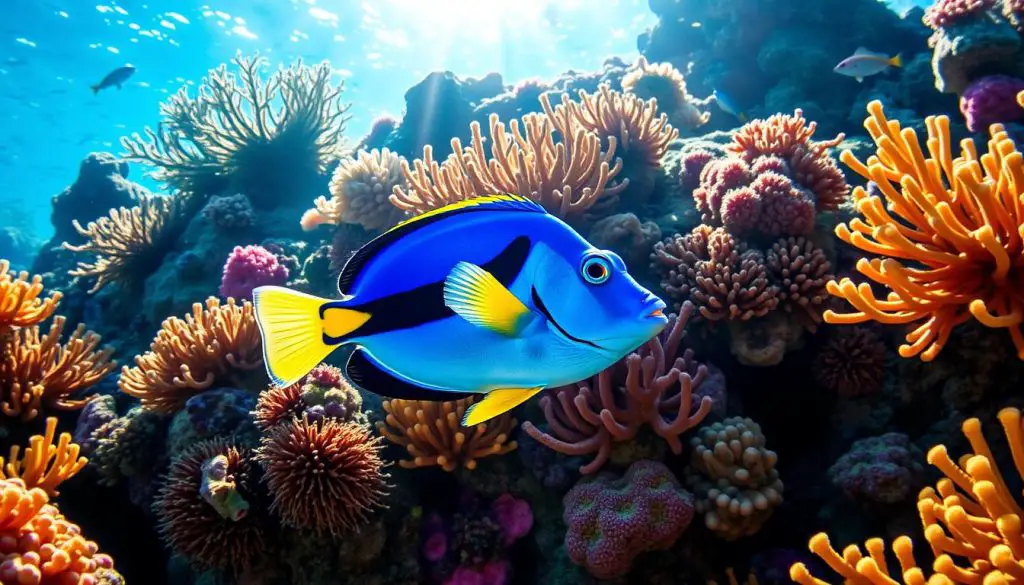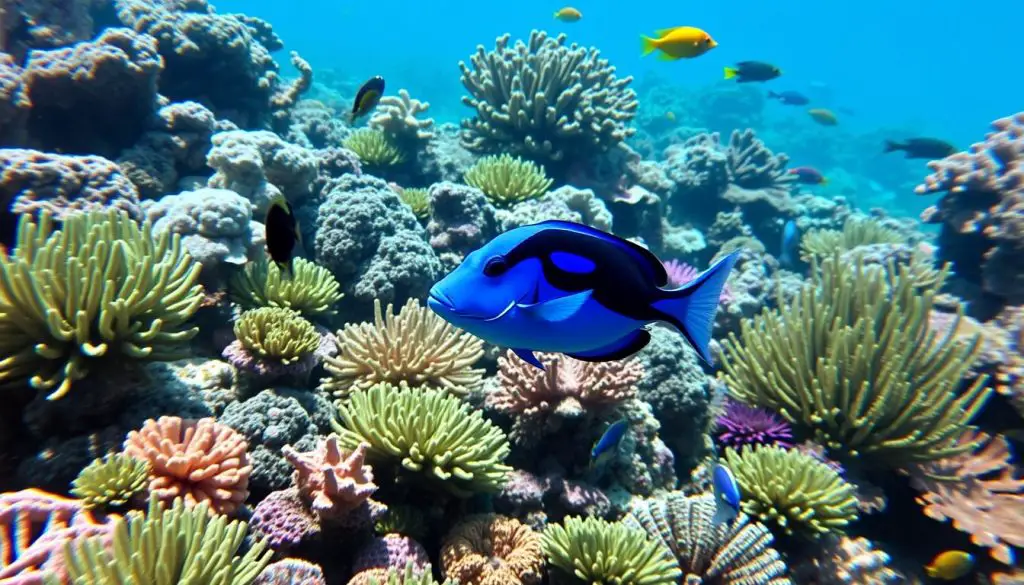The blue hippo tang, also known as the blue tang or regal tang, is a stunning saltwater fish. It’s a favorite in many home aquariums. Its bright blue color, unique shape, and plant-eating habits make it stand out. This fish can do well in a well-set reef tank.
Key Takeaways
- The blue hippo tang is a members of the surgeonfish family, known for their vibrant colors and unique body shapes.
- These marine fish are native to the Pacific Ocean, living in coral reef environments.
- Blue hippo tangs are herbivores, requiring a specialized diet of algae and other plant-based foods.
- Proper tank setup, including ample swimming space and hiding places, is crucial for the success of these fish in home aquariums.
- Blue hippo tangs can be compatible with other peaceful marine species, but their semi-aggressive behavior must be considered.
Introducing the Blue Hippo Tang
The blue hippo tang is a saltwater fish that catches the eye with its bright blue color and special shape. It looks a bit like a hippo, which makes it stand out in a reef tank. This fish is a herbivore, which means it eats plants, and it’s a beautiful sight to see.
Captivating Coloration and Unique Body Shape
This fish is famous for its blue accents all over its body, with yellow colors on its fins and dorsal area. Its unique shape and color make it a standout in the sea. It looks a bit like a hippo, which is how it got its name.
Being a herbivore, the blue hippo tang is key to keeping a reef tank healthy. It’s also reef safe, making it a favorite among those who keep fish tanks. It eats algae and adds bright colors to the tank.
“The blue hippo tang is a true gem of the surgeonfish family, captivating with its striking appearance and important role in reef ecosystems.”
Natural Habitat: The Pacific Ocean
The vibrant blue hippo tang lives mainly in the warm waters of the Pacific Ocean. These fish are key to keeping the reef environment healthy. They help balance the ecosystem.
They live in many depths, from shallow reefs to deep ocean areas. The blue hippo tang fits well in the Pacific Ocean’s varied underwater world. Their unique shape and colors help them hide among the coral, making them a wonder to see for divers and aquarium fans.
“The Pacific Ocean is home to an incredible diversity of marine life, and the blue hippo tang is undoubtedly one of its most mesmerizing inhabitants.”
As herbivores, blue hippo tangs eat a lot of algae. This helps keep the reef environment healthy. They make sure the coral reefs stay vibrant and healthy.
Knowing where the blue hippo tang comes from is key for those who keep them in tanks. By making their tanks like the Pacific Ocean’s reef environment, they help these surgeonfish live happy and healthy lives.
The Blue Hippo Tang in Saltwater Aquariums
Keeping a saltwater aquarium with a blue hippo tang needs careful planning. These fish are usually reef-safe. But, they can be semi-aggressive with smaller or slower fish. It’s important to set up the tank right for the blue hippo tang to do well.
Importance of Proper Tank Setup
To make a good home for the blue hippo tang, aquarium lovers should pay attention to these points:
- Spacious tank size: Blue hippo tangs need lots of room to swim, so a tank of at least 125 gallons is a must.
- Abundant live rock: Adding a lot of live rock gives them places to hide and helps keep the water clean by filtering it naturally.
- Healthy algae growth: These fish love to eat algae, so having plenty around is key for their diet.
By setting up and maintaining the saltwater aquarium correctly, owners can make a great home for the beautiful blue hippo tang.
“The key to keeping a blue hippo tang healthy and happy in a home aquarium is providing the right balance of space, hiding spots, and a consistent food source.”
Blue Hippo Tang: A Herbivore’s Delight
The blue hippo tang is a true herbivore that needs a special diet to do well in a saltwater tank. This beautiful fish from the Pacific Ocean eats mainly algae and plants to stay healthy and full of energy.
In a reef tank, the blue hippo tang is key to keeping algae in check. This helps keep the delicate balance of the ecosystem. If you have this fish in your tank, make sure it gets a variety of algae and plant foods.
Feeding the Blue Hippo Tang
To keep your blue hippo tang happy and healthy, try these foods:
- High-quality marine algae, such as Caulerpa, Chaetomorpha, and Cladophora
- Spirulina-based flakes or pellets
- Seaweed sheets or vegetable-based aquarium foods
- Occasional supplements of fresh, chopped vegetables like lettuce, kale, or zucchini
Feeding your blue hippo tang a varied and rich herbivore diet is key. This ensures it thrives in the reef environment and keeps the algae balance in your tank healthy.
“The blue hippo tang is a true herbivore, and its dietary needs must be met to ensure its long-term well-being in a saltwater aquarium.”
Compatibility with Other Marine Fish
When you think about keeping a blue hippo tang in a saltwater tank, think about how it gets along with other fish. They are mostly “reef-safe,” meaning they won’t hurt corals and invertebrates. But, they can be semi-aggressive towards smaller or slower fish.
Reef Safe or Semi-Aggressive?
The blue hippo tang’s nature can change, so you need to check the size and nature of your other fish before adding one. These fish like to claim their territory and might nip or chase smaller fish. This happens if they feel their space is being taken.
To keep the peace in your tank, put blue hippo tangs with big, calm, or semi-aggressive fish. Some good friends for them could be:
- Other big tangs, like the yellow or Scopas tang
- Angelfish, such as the French or Regal angelfish
- Larger wrasses, like the tuskfish or parrotfish
- Smaller sharks, such as the epaulette shark or black-tip reef shark
The blue hippo tang’s friends also depend on the tank’s size, setup, and the fish’s own personality. Watching them and making changes as needed is key to a peaceful tank.
| Fish Species | Compatibility with Blue Hippo Tang |
|---|---|
| Yellow Tang | Highly Compatible |
| French Angelfish | Moderately Compatible |
| Tuskfish | Moderately Compatible |
| Black-tip Reef Shark | Moderately Compatible |
| Clownfish | Low Compatibility |
“The blue hippo tang’s compatibility with other marine fish can be a delicate balance, requiring careful consideration and monitoring to maintain a thriving and peaceful aquarium ecosystem.”
Caring for the Vibrant Blue Hippo Tang
Looking after the blue hippo tang is key to its health and happiness in a home tank. This saltwater fish needs careful attention, from keeping the water quality high to feeding it a diet full of algae. By meeting its needs, aquarists can help this beautiful fish flourish.
Optimal Tank Size and Setup
The blue hippo tang is a big fish that needs a large tank to swim around. A tank of at least 75 gallons is a good start, but bigger is better for its growth and happiness. The tank should have a strong filter, good water flow, and lots of live rock or coral for the fish to explore.
Water Quality Considerations
Keeping the water quality top-notch is vital for the blue hippo tang. Make sure to keep ammonia, nitrites, and nitrates low with regular water changes and a good filter. Also, watch the pH, temperature, and salt levels closely to match its Pacific Ocean home.
Dietary Requirements
The blue hippo tang loves to eat algae and plants. Feed it a mix of dried seaweed, leafy greens, and special pellets or flakes for herbivores. Sometimes, add boiled veggies or spirulina for extra nutrition.
Following these tips for aquarium care will help create the best home for the blue hippo tang. This way, it can show off its bright colors and unique personality in your tank.
| Aquarium Parameter | Recommended Range |
|---|---|
| Tank Size | Minimum 75 gallons |
| pH | 8.1 – 8.4 |
| Temperature | 72°F – 82°F (22°C – 28°C) |
| Salinity | 1.023 – 1.025 SG |
| Ammonia | 0 ppm |
| Nitrite | 0 ppm |
| Nitrate | Less than 20 ppm |

“Proper aquarium care is the key to keeping the blue hippo tang healthy and thriving in the home environment.”
Fascinating Facts About the Surgeonfish Family
The blue hippo tang is part of the surgeonfish family. These fish are known for their special traits and how they have changed over time. They are loved by people who keep fish in tanks and by scientists who study the sea.
Evolution and Unique Features
Surgeonfish, including the blue hippo tang, have sharp spines on their tails. These spines look like a surgeon’s tools and help protect them from predators. Over millions of years, surgeonfish have also changed to look different and blend in with their coral reef homes.
What makes surgeonfish so interesting is how they have adapted to their lives underwater. They have evolved to move through tight spaces and avoid danger easily. Their flat bodies help them do this.
- Sharp, scalpel-like tail spines for defense
- Distinctive body shapes and coloration patterns
- Flat, disc-shaped bodies for agile movement
- Diverse feeding habits, from grazing on algae to hunting small prey
Surgeonfish are not just pretty to look at. They are also important to coral reefs. They eat algae and help keep the reef healthy. This helps the reef stay full of life and strong.
The blue hippo tang is just one of the many interesting surgeonfish. Their unique looks and special traits make them a favorite among fish lovers and scientists.
Blue Hippo Tang: A Stunning Addition
The blue hippo tang is a captivating sight in any vibrant reef aquarium. They stand out with their bright blue color and unique shape. They can change the look of a saltwater tank in a big way.
Blue hippo tangs are more than just pretty to look at. They play a key role in keeping the aquarium healthy. As herbivores, they eat algae, which keeps the reef environment balanced. They are calm and curious, making them interesting to watch as they move through the tank.
“The blue hippo tang is a true showstopper, captivating the eye with its brilliant hues and mesmerizing movements.”
If you want a reef aquarium that looks great and is full of life, the blue hippo tang is a great pick. Their bright colors and lively behavior make the tank feel like an underwater paradise. It brings a sense of wonder and appreciation for the ocean’s beauty.

The blue hippo tang is a standout addition to any vibrant reef aquarium. It can make the tank look better and work better, whether it’s the main attraction or part of a larger group.
Tips for Successful Aquarium Keeping
Keeping a blue hippo tang in a home aquarium means paying close attention to several key areas. A large tank with top-notch water quality is key for their health. This fish needs a clean and safe home to thrive.
Feeding your blue hippo tang a varied diet full of algae is vital. Since they eat mainly plants, having different marine plants and algae in the tank is a must. This ensures they stay healthy and happy.
Choosing the right tank mates is also crucial. Blue hippo tangs can be a bit aggressive and don’t always get along with other fish. Knowing which fish they can live with helps you create a peaceful reef tank.
